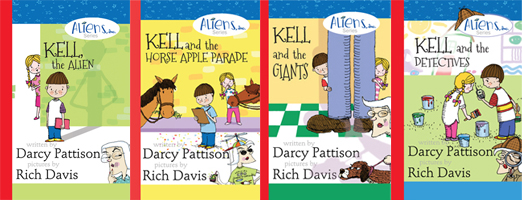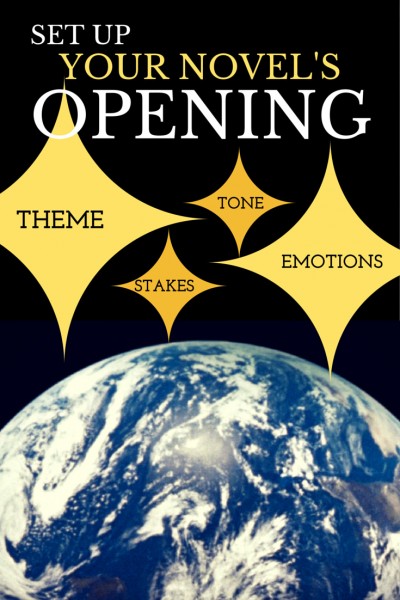The Aliens Inc, Chapter Book Series
Try Book 1 for Free

I’ve been fiddling with the opening of the second book of a trilogy, Blue Planets, for several weeks, trying to plot, trying to think of new and exciting ways to tell the story. I KNOW the story. It’s bringing it down to specifics that’s hard.
Part of my problem is that Book 1 in this trilogy opens with a scene that echoes the movie “Jaws.” That book and movie has a powerful, action packed opening image and scene that sets up the stakes clearly. My Book 1 opening echoes the action, and twists the meaning into a new, surprising direction. I like the opening I create there.
But it also set up a problem: How can I echo the “Jaws” opening for Book 2?
I’ve struggled for a couple weeks with this question and finally found the answer.
Don’t. Find another image that works.
Using a Mentor Text or Story

Perhaps, though, the process I used in the opening for Book 1 can be repeated for Book 2. I used “Jaws” as a mentor text, echoing its action and setting the stakes very high. What if I found a different mentor text/movie for the next book?
At Blake Snyder’s Save the Cat site, they’ve done a series of analyses of movie plots that are called Beat Sheets under his system. I decided to go through them and write a short summary of how I could or couldn’t echo the different movies for this opening. I knew that I had to approach it as a writing exercise and just go overboard and let the ideas flow.
In an hour, I wrote the summaries for the following twenty possible opening scenes. After, I went back and wrote a sentence of how the closing scene might echo back to the opening scene. That closing scene ideas — only written after all the opening scene summaries were completed — helped me evaluate how well this opening fit my story. Note also that I drew a blank on about three of the movie openings and couldn’t figure out how it would fit my story.
The Grunt Work: Writing 20 Possible Summaries of Opening Scene
Note: You won’t understand what some of this means, since I’m not explaining all the background, setting, characters, etc. That’s OK. The point is to see how I echoed the mentor text/story in some way. The link for each movie title goes to the Save the Cat plot analysis for that movie, where you can read the opening image synopsis and compare it to mine. You may think some of my opening as strangely at odds with the mentor text. That’s fine. I consider the mentor text/story as merely a starting point and go where the story takes me.
- A la Ultron.
The opening image is of a huge conch shell that is blown and echoes throughout the ocean. Jake is swimming and hears it—has to stop up his ears it’s so loud. But no human hears it—at a weird frequency. It’s an emergency call to the Mer, but Jake doesn’t know that yet. The umjaadi plague is spreading and they still don’t know what it is.
Final Echo: A hospital ward full of sick patients and the doctor telling someone that unless someone finds a cure, they’ll all die. The Mer will be gone. - A la The Conversation .
The opening image is Edinburgh, Scotland the castle with a full moon overhead. Home of Harry Potter, the setting is almost mythical. But the reality of walking the seven hills, and climbing up the highest pulls Jake back to Earth (so to speak). From the top, he sees the Frith of Forth and the bridge—with the aquarium under it, where they’ll go tomorrow.
Final echo: back on the hill, Jake now understands what is beneath the waters he sees. - A la Whiplash.
Jake is swimming laps in a pool—with no one around—when Cy Blevins walks in. You’re not related to the Commander, you’re the Ambassador’s son—we know all about you. OK. So, what? You can’t live here.
Jake swims, but wants to jump out and beat up Cy.
Final echo: No. Doesn’t work. - A la Birdman.
Jake is swimming and keeps asking himself, “How did we wind up here? Am I Earthling or Risonian?” He turns sharks into tour guides, he is thrilled with electric shock from eels, he talks to octopuses.
Final echo: I am Earthling.
Jake is a toddler swimming on Rison and when a camouflaged creature (octopus-like) unfurls, he is startled and starts to cry. Turns to Swann for comfort, but Swann turns him around and says, SEE. Watch. Learn to see.
Final echo: Swimming and points out a camouflaged creature to Swann.
B/w documentary about octopuses, compared with what we know today. They were once feared as monsters, but we now know they are very intelligent (playing with toys to get crabs). We see what we expect to see, and that changes slowly. (Or: what’s alien comes from what’s in OUR heads, not what we see in front of us.)
Final echo: B/W Risonain documentary on first contact Earth—from the Risonian POV. We now know Earthlings are much more complicated and intelligent than we thought at first.
Go for a memory and emotion. Jake relives a moment with Em where they kiss—or almost kiss. But then shakes himself. No. She didn’t want to be friends.
Final echo: A final kiss.
The camera moves along an underwater ship and reveals it to be a U-Boat. Follow with the scene of the DCS dive.
Final echo: Maybe Mom is sick from something on Earth?
(Scene with dramatic first kill – will he shoot a kid?)
Scene with dramatic first ______?
Clearly, this one didn’t work.
From a boat, Dr. Max Bari lowers a figure on a stretcher into the ocean, then dives in after her—without scuba gear. He tugs the stretcher deeper and deeper until there are lights in the distance. . .
Final echo: Jake lifts off in a rocket ship and watches Earth get smaller and smaller in the distance, and turns his face toward Rison and hopes. . .
Setting: Sanfransokyo
My Setting: Aberforth Hills
Final echo: Earth leaders touring Aberforth Hills
In a classroom, they are going around telling what their fathers do. A young Jake says his father is a test tube. No, it’s the Leader of our People. No, it’s really a test tube.
Final echo: Jake with Dad.
(Ambush of triumphant soldier by vanquished.) No ideas. Didn’t work for me.
(Sharp contrast of emotions: head on shoulder of husband contrasted with his thoughts of killing her. Result: Worry for her safety)
Contrasting emotions? Invade Earth and just take it! Take the long, slow route to a long-term healthy relationship.
Mom is giving a speech to the world leaders about Rison’s needs. Jake is drawing pictures of skulls and wishing he could blast all of Earth so Risonians could take over. How can they ever live together on the same planet and not kill each other?
Final echo: Fight that ends in a truce.
Sitting alone, Jake is listening to a cd mix that Em gave him and wishing they hadn’t quarreled. He gets a call from Marisa, who says she wants to meet with him. I hear you’re going to Edinburgh. Mom and Dad aren’t saying much—but I think Em has been kidnapped and they know who did it, but they won’t go after her. I think she’s somewhere near Edinburgh.
Final echo: Jake gives Em a cd of Risonian operas and says, I’ll be back with the cure.
Jake is spinning a globe of the world and narrating for his class (OR Swann) back home-videoconference call. He tells of how Earthlings/US once put it’s citizens in jail because they “might” have been traitors. How they questioned the loyalty of citizen merely because of their heritage. How unfair it is and how he’s worried that the Risonians will be even more feared and how suspicion will abound.
Final echo: Suspicious news reports: There are fears that Jake Quad-di is returning home with intelligence that will allow the Risonians to attack. His mother, Ambassador Dayexi Quad-di assures us that he only returns to bring back a cure for the Phoke. But why would he risk his life for them?
The camera pans across oceans, racing across the seas, until it zooms in on a conference room where Mom is talking to world leaders, a clear image of politics/diplomacy.
Final echo: Not emotional enough to pursue.
Start with pan down from The End—the last movie—and sing about how the studio ordered a sequel.
Final echo: No. Don’t like this metadata stuff.
Jake is writing a letter to the editor, or editorial or something—and we pull back to see that he’s writing it for Mom. He’s her assistant now, and she trusts his knowledge of English and culture. (Not emotional enough. HER is a love story, so the emotions there are about truly falling in love. It’s not going to work in this story.)
The scene opens on a rowdy swimming pool with kids taking bets. Jake lines up with another guy and when the whistle blows, the other boy dives in and races away. When that guy touches the opposite wall, Jake dives in, velcroes his legs and swims. He almost beats the other guy back, but is won out by a touch.
I win! Says the other swimmer.
Jake shakes his head. He swam almost twice as fast—and the Earthling says he won? That’s crazy.
We’re never letting you compete in the Olympics! Says one kid.
Final echo: Argument: You think I can do miracles. Sure, I can outswim any human boy, but on Rison, I’m nothing. I’m just a normal kid. How can I find the cure to the umjaadi in time? I can’t. But I have to try.
Notice that I didn’t hold myself to an impossible standard. If the movie’s opening didn’t spark something almost immediately, I moved on. Further, I didn’t stop at just one try. I persevered, knowing that I needed to fully explore my options.
Evaluate the Possible Openings
After writing all of these, I had to evaluate which one fit my story best. First, I went back and added the Final Echo to each, so I’d know if it fit the theme/plot/characters well enough to carry through the whole story. In other words, I double checked my ideas about the story, my intentions.
Then I asked these questions of each opening:
- Which sets the tone I want?
- Which sets the emotional problems?
- Which sets the themes?
- Which one sets up the stakes as very high?
Results of Opening Images Writing Exercise
I found several good images that took me in new and different directions than I’d previously been trying—and that’s exciting.
- Warning conch shell – warning comes true, all Mer sick.
- Jake as toddler scared by octopus-like creature un-camouflaging – Watches old Risonian documentary and realizes that Earthlings are complicated.
- Dr. Max lowers a patient into the water and goes into a foreign world – Jake lifts off in rocket for a foreign world.
- Listens to Em’s cd – gives her a cd when he leaves.
- Jake narrates the globe – a news show narrates Jake’s trip to Rison.
- Jake outswims Earthlings – but realizes he’s just a normal kid on Rison.
Which one did I choose? Actually, several. Because I have a main plot and several subplots, I realized that several of these can work in sequence to open the different subplots.
Sometimes, I approach a story methodically, just doing a writing exercise. This time, I was stuck, and the exercise unstuck me. That was a valuable hour of writing!




I actually like opening with character first. Or at least something that puts questions in my mind. Ha, you’re right, maybe too many of “opening with actions” may turn into a cliche.
I’m glad you made this point, Kenda. “Action” and being “active” in a scene are different meanings. Although this beginnings are not “action-oriented” they are no way passive either.
You are probably learning so much with working with your editor. Great what she had to say about the reader needs to have questions. So true.
So glad you enjoyed the post. :) I think also through description through a character’s eyes, you can learn so much about the character. You can see an image more powerful that way too.
I know right? It’s almost like getting a “two for one” when it comes to description and character development.